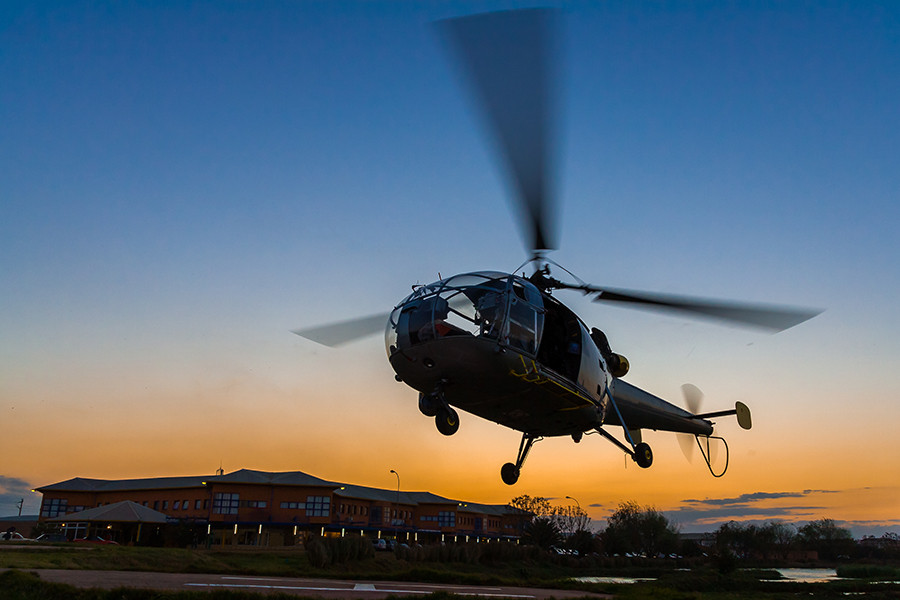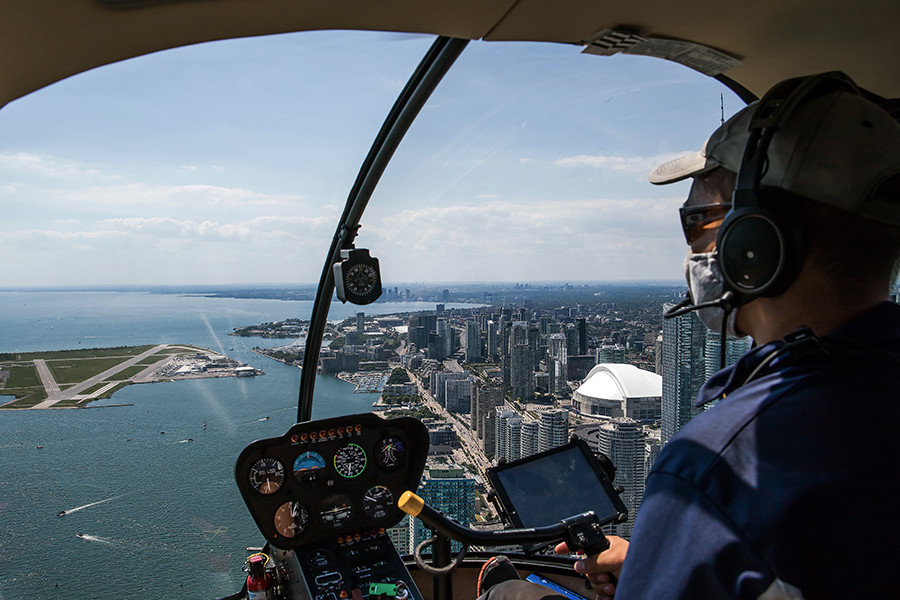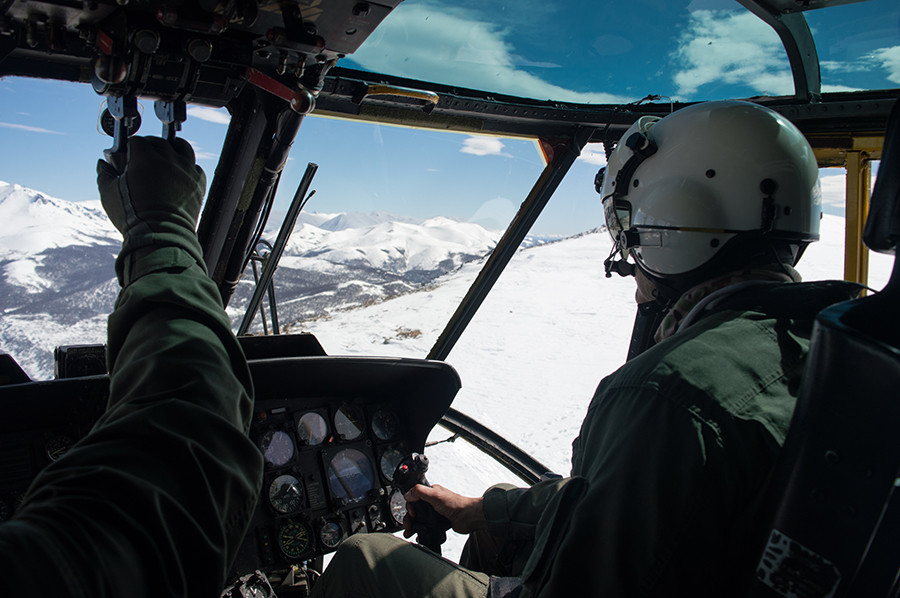Why Do Helicopters Fly At Night? Helicopters, with their unique vertical takeoff and landing capabilities, are indispensable in various nighttime operations, making the ability to fly at night a crucial skill for pilots. At flyermedia.net, we aim to provide you with the essential knowledge to understand this fascinating aspect of aviation. Mastering night flying opens up exciting possibilities, enhancing your aerial expertise and expanding the versatility of rotorcraft operations. Let’s explore the world of helicopter night flying, highlighting the necessary qualifications, training experiences, and vital roles that require pilots to navigate the skies after sunset.
1. What Qualifications Are Needed For Helicopter Night Flying?
Helicopter night flying qualifications vary depending on the country. In the US, pilots receive night flying training during their Private Pilot training, allowing them to fly at night. The FAA requires every pilot to complete at least three hours of night flying training during their helicopter Private Pilot training, and they are then allowed to fly a helicopter at night by themselves. Additional night training is required for a commercial pilot certificate, but no separate rating is needed.
However, the FAA emphasizes that being allowed to fly at night doesn’t automatically mean a pilot should fly at night without proper experience. Night flying over unlit areas requires instrument flying skills and experience. If the pilot doesn’t have extensive instrument flying experience, they need to be trained in using night-vision goggles or have a helicopter with the necessary instrumentation.
Requirements Around the World
| Country | Requirements |
|---|---|
| United Kingdom | Applicants need 100 hours of flight time in helicopters after PPL(H) issuance, 60 hours as pilot in command, and 20 hours of cross-country flight. The night qualification course includes five hours of theoretical instruction, ten hours of dual helicopter instrument instruction, and five hours of helicopter night training. This is according to the UK Civil Aviation Authority. |
| Canada | Similar requirements to the UK, involving significant flight hours and specialized training. |
| United States | Pilots undergo at least three hours of night flying training during their Private Pilot training, allowing them to fly at night. Further training is required for a commercial pilot certificate, but no separate rating is needed. |
2. What Is It Like To Train For Helicopter Night Flying?
Night flying training introduces unique challenges and skills required to navigate the darkness. One common memory is how difficult it was to even arrange it in the first place. Balancing commercial flying courses over the summer, when there are longer days and better weather, can be difficult. This is because of the long days when it comes to night flying. It can take until late October before night flying training can be arranged.
Key Aspects of Night Flying Training
- Circuits, Hovering, and Take-offs/Landings: Hovering and hover-taxiing at night are difficult due to impaired depth perception, often leading to excessive speed. Transitions to forward flight use a towering take-off technique. Circuits are similar to daytime flying, but with increased reliance on instruments. Approaches require a constant angle, making it harder to judge ground speed.
- Navigation: Navigation at night involves aiming for lighted areas, but distance judgment can be difficult, even for well-lit towns. Recognizing cloud cover by the disappearance of lights is crucial.
- Emergencies: Engine-off landings at night use a constant attitude autorotation technique with a speed of 40 knots and minimal flare. Selecting a suitable landing area is extremely challenging due to limited visibility.
- Cross-Country Flights: Cross-country flights over city centers at night can be spectacular but challenging due to winds. Maintaining control in windy conditions requires experience and confidence.
 Night-Helicopter-Flying
Night-Helicopter-Flying
3. Why Should You Fly Helicopters At Night?
There are compelling reasons to consider night helicopter flying, adding a new dimension to your flying experience. As a private helicopter pilot, there is no particular reason why you need to fly at night, but it can be most enjoyable. It will also add a new dimension to your flying, and you will acquire a lot of extra knowledge when learning to fly at night.
- Enjoyment: Night flying offers a unique and peaceful experience, providing a different perspective of the world from above.
- Skill Enhancement: You’ll gain additional knowledge and skills, enriching your overall flying capabilities.
- Emergency Preparedness: Being able to fly at night equips you with the skills and legal permission to handle unexpected situations after sunset.
4. What Helicopter Jobs Require Night Flying?
Several critical jobs rely on the ability to fly helicopters at night, ensuring services are available around the clock. If you’re considering a career in aviation, here are some of the jobs that require night helicopter flying.
4.1. Police Helicopter Pilots
Police helicopters operate at night to monitor and respond to criminal activities. They use observation and tracking to support law enforcement efforts, circling over neighborhoods to cover large areas efficiently. According to the National Police Aviation Association, police helicopters are essential for reducing crime rates and enhancing public safety.
Key Responsibilities of Police Helicopter Pilots:
- Observation and Surveillance: Monitoring areas for suspicious activities.
- Tracking: Following suspects and vehicles from the air.
- Coordination: Communicating with ground units to provide real-time information.
- Night Vision Technology: Using night vision goggles for enhanced visibility.
 Police-Helicopter
Police-Helicopter
4.2. Air Ambulance Helicopter Pilots
Air ambulance pilots provide rapid medical transport, where time is critical to patient survival. They operate 24/7 to ensure quick responses to accidents and emergencies. The capabilities of medevac helicopters can vary. Some EMS helicopters may only be allowed to operate between lit airports and hospital helipads, whereas others may be able to land in the closest park or field, even on the darkest nights.
Essential Skills for Air Ambulance Pilots:
- Rapid Response: Quickly reaching accident scenes.
- Patient Transfer: Safely transporting patients to hospitals.
- All-Weather Operation: Flying in various weather conditions, including at night.
- Advanced Navigation: Using sophisticated navigation systems for precise landings.
- Coordination: Collaborating with medical teams to ensure patient care.
4.3. Corporate And VIP Helicopter Pilots
Corporate and VIP helicopter pilots provide efficient transportation for executives and important personnel. They operate day and night to meet the demands of their clients, using helicopters equipped for various conditions.
Typical Duties of Corporate and VIP Helicopter Pilots:
- Executive Transport: Providing fast and reliable transportation for business leaders.
- Flexible Scheduling: Accommodating client schedules with flights at any time.
- Rooftop Landings: Landing on helipads in urban areas.
- Advanced Technology: Operating helicopters with sophisticated navigation and safety features.
4.4. Military Helicopter Pilots
Military helicopter pilots must be proficient in night flying to conduct covert operations and training exercises. They use night vision technology and advanced instrumentation to maintain operational readiness. The art of sneaking up on the enemy is one of the military’s greatest advantages and to do this safely requires extensive training.
Critical Functions of Military Helicopter Pilots:
- Night Operations: Conducting missions in low-light conditions.
- Reconnaissance: Gathering intelligence through aerial surveillance.
- Troop Transport: Moving personnel and equipment to strategic locations.
- Advanced Technology: Utilizing night vision goggles and synthetic vision systems.
- Coordination: Working with ground forces to execute missions effectively.
 Military-Helicopter
Military-Helicopter
5. How Does Weather Impact Night Helicopter Flying?
Weather significantly affects night helicopter flying, demanding careful planning and advanced skills. Reduced visibility due to fog, clouds, rain, or snow increases the risks associated with navigation and landing. Pilots must rely more on instruments and navigation systems, making instrument proficiency crucial for safe night flying. According to the FAA, weather-related accidents are more common at night, highlighting the importance of thorough pre-flight weather checks and continuous in-flight monitoring.
Key Weather Considerations:
- Visibility: Fog, clouds, and precipitation reduce visibility, making visual navigation challenging.
- Wind: Strong winds can affect helicopter stability, especially during landing.
- Temperature: Cold temperatures can impact engine performance and increase the risk of icing.
- Turbulence: Nighttime turbulence can be unpredictable and challenging to manage.
6. What Safety Measures Are Essential For Night Helicopter Flying?
Safety is paramount in night helicopter flying. Proper training, aircraft maintenance, and adherence to regulations are crucial.
Essential Safety Measures:
- Pre-Flight Checks: Thoroughly inspect the helicopter and its systems before each flight.
- Navigation Systems: Use reliable GPS and navigation tools.
- Communication: Maintain constant communication with air traffic control.
- Emergency Procedures: Be prepared for emergencies with well-practiced procedures.
- Lighting: Ensure all aircraft lights are functioning correctly to increase visibility.
7. What Are The Challenges Of Flying Over Different Terrains At Night?
Flying over various terrains at night presents unique challenges. Over water, the lack of visual references can cause spatial disorientation. Mountainous areas require precise navigation to avoid obstacles. Urban environments demand awareness of buildings and restricted airspace. The FAA recommends additional training for pilots operating in these diverse terrains.
Terrain-Specific Challenges:
- Water: Lack of visual references leading to spatial disorientation.
- Mountains: Difficult navigation due to terrain and weather conditions.
- Urban Areas: Obstacles such as buildings and restricted airspace.
- Rural Areas: Limited lighting and few landmarks for navigation.
8. What Technologies Enhance Safety During Night Helicopter Flying?
Advanced technologies greatly enhance safety during night helicopter flying. Night vision goggles (NVGs) improve visibility in low-light conditions. Synthetic vision systems (SVS) provide a virtual representation of the terrain, aiding navigation. Enhanced ground proximity warning systems (EGPWS) alert pilots to potential collisions. These technologies, as highlighted by the Helicopter Association International (HAI), are essential for modern night flying operations.
Key Safety-Enhancing Technologies:
- Night Vision Goggles (NVGs): Enhance visibility in low-light conditions.
- Synthetic Vision Systems (SVS): Provide a virtual representation of terrain.
- Enhanced Ground Proximity Warning Systems (EGPWS): Alert pilots to potential collisions.
- Infrared Cameras: Detect heat signatures for search and rescue operations.
9. How Do Regulations Govern Night Helicopter Flying In The USA?
In the USA, the FAA regulates night helicopter flying. These regulations cover pilot qualifications, aircraft equipment, and operational procedures. Pilots must adhere to specific lighting requirements, visibility minimums, and airspace restrictions. Understanding and complying with these regulations is crucial for safe and legal night flying. The FAA provides comprehensive guidelines in the Federal Aviation Regulations (FARs).
Key FAA Regulations:
- Pilot Qualifications: Requirements for night flying experience and training.
- Aircraft Equipment: Mandatory lighting and navigation systems.
- Operational Procedures: Guidelines for takeoff, landing, and en-route flying.
- Airspace Restrictions: Rules for operating in different types of airspace at night.
10. Where Can You Find Helicopter Training Programs In The USA?
There are numerous helicopter training programs available in the USA, catering to various skill levels and career aspirations.
Top Helicopter Training Programs in the USA
| School | Location | Description |
|---|---|---|
| Embry-Riddle Aeronautical University | Daytona Beach, FL | Embry-Riddle Aeronautical University is a renowned institution offering comprehensive aviation programs, including helicopter flight training. Known for its rigorous curriculum and state-of-the-art facilities, Embry-Riddle prepares students for successful careers in aviation. The university emphasizes safety, professionalism, and academic excellence, making it a top choice for aspiring pilots. Embry-Riddle Aeronautical University provides detailed information on its programs and admission requirements. |
| Hillsboro Aero Academy | Hillsboro, OR | Hillsboro Aero Academy is a leading flight training institution offering a range of helicopter courses. With experienced instructors and a diverse fleet, the academy provides hands-on training in various flight conditions. Students benefit from the academy’s focus on safety and career development, preparing them for roles in commercial aviation. Hillsboro Aero Academy offers detailed information on its programs and admission requirements. |
| Bristow Academy | Titusville, FL | Bristow Academy specializes in helicopter flight training for commercial and offshore operations. The academy is known for its advanced simulation technology and experienced instructors, preparing pilots for challenging environments. Bristow Academy’s focus on safety and industry partnerships makes it a top choice for aspiring commercial helicopter pilots. Bristow Academy provides detailed information on its programs and admission requirements. |
| FlightSafety Academy | Vero Beach, FL | FlightSafety Academy offers comprehensive helicopter training programs with a focus on safety and proficiency. The academy utilizes advanced training technologies and experienced instructors to prepare students for various aviation careers. FlightSafety Academy is known for its commitment to excellence and its comprehensive curriculum. FlightSafety Academy offers detailed information on its programs and admission requirements. |
| ATP Flight School | Various Locations | ATP Flight School offers accelerated helicopter training programs designed to get students career-ready quickly. With a focus on practical skills and industry connections, ATP Flight School prepares students for roles in commercial aviation. The school’s structured curriculum and experienced instructors ensure students receive comprehensive training. ATP Flight School offers detailed information on its programs and admission requirements. |
| Western Helicopters | Rialto, CA | Western Helicopters offers a range of helicopter training programs, including private pilot, commercial pilot, and flight instructor courses. With experienced instructors and a focus on safety, Western Helicopters provides students with the skills and knowledge needed for successful aviation careers. The school’s personalized approach and commitment to student success make it a popular choice. Western Helicopters offers detailed information on its programs and admission requirements. |
| Rotorcraft Collective | Fort Worth, TX | Rotorcraft Collective offers a range of helicopter training programs, including private pilot, commercial pilot, and flight instructor courses. With experienced instructors and a focus on safety, Rotorcraft Collective provides students with the skills and knowledge needed for successful aviation careers. The school’s personalized approach and commitment to student success make it a popular choice. Rotorcraft Collective offers detailed information on its programs and admission requirements. |
| Quantum Helicopters | Chandler, AZ | Quantum Helicopters offers a range of helicopter training programs, including private pilot, commercial pilot, and flight instructor courses. With experienced instructors and a focus on safety, Quantum Helicopters provides students with the skills and knowledge needed for successful aviation careers. The school’s personalized approach and commitment to student success make it a popular choice. Quantum Helicopters offers detailed information on its programs and admission requirements. |
| Guidance Aviation | Prescott, AZ and Baton Rouge, LA | Guidance Aviation offers a range of helicopter training programs, including private pilot, commercial pilot, and flight instructor courses. With experienced instructors and a focus on safety, Guidance Aviation provides students with the skills and knowledge needed for successful aviation careers. The school’s personalized approach and commitment to student success make it a popular choice. Guidance Aviation offers detailed information on its programs and admission requirements. |
| United Rotorcraft | Decatur, TX | United Rotorcraft offers a range of helicopter training programs, including private pilot, commercial pilot, and flight instructor courses. With experienced instructors and a focus on safety, United Rotorcraft provides students with the skills and knowledge needed for successful aviation careers. The school’s personalized approach and commitment to student success make it a popular choice. United Rotorcraft offers detailed information on its programs and admission requirements. |
FAQ: Common Questions About Night Helicopter Flying
1. Is it safe to fly a helicopter at night?
Yes, with proper training, equipment, and adherence to safety regulations, night helicopter flying can be safe.
2. What special equipment is needed for night helicopter flying?
Essential equipment includes functioning navigation lights, GPS, communication systems, and, in some cases, night vision goggles.
3. How does weather affect night helicopter flying?
Adverse weather conditions like fog, clouds, and precipitation can significantly reduce visibility, making night flying more challenging and risky.
4. What are the main challenges of night helicopter flying?
Challenges include reduced visibility, spatial disorientation, and the need for precise instrument flying skills.
5. Can private pilots fly helicopters at night?
Yes, private pilots can fly at night if they have received the necessary training and meet the regulatory requirements.
6. What types of jobs require night helicopter flying?
Jobs include police, air ambulance, corporate transport, and military operations.
7. How do night vision goggles (NVGs) enhance safety?
NVGs improve visibility in low-light conditions, helping pilots navigate and identify potential hazards.
8. What is spatial disorientation, and how can it be avoided?
Spatial disorientation is a loss of awareness of one’s position and attitude. It can be avoided through proper training and reliance on instruments.
9. What regulations govern night helicopter flying in the USA?
The FAA regulates night helicopter flying, covering pilot qualifications, aircraft equipment, and operational procedures.
10. Where can I get training for night helicopter flying?
Various flight schools and academies across the USA offer specialized night helicopter flying training programs.
Conclusion
Night helicopter flying is a unique and essential aspect of aviation, demanding specialized skills and training. Whether for law enforcement, medical transport, corporate travel, or military operations, the ability to navigate the skies after dark is crucial. At flyermedia.net, we aim to provide valuable information to help you understand the complexities and rewards of night helicopter flying.
Ready to take your aviation knowledge further? Explore flyermedia.net for in-depth articles, training program listings, and career opportunities in the exciting world of helicopter aviation. Contact us at Address: 600 S Clyde Morris Blvd, Daytona Beach, FL 32114, United States or Phone: +1 (386) 226-6000. Visit our website at flyermedia.net and start your journey toward the skies today!